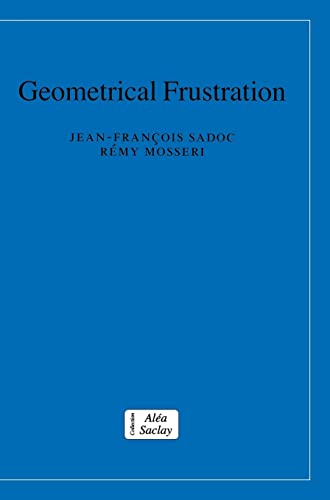Items related to Geometrical Frustration (Collection Alea-Saclay: Monographs...
Geometrical Frustration (Collection Alea-Saclay: Monographs and Texts in Statistical Physics) - Hardcover

Synopsis
This book shows how the concept of geometrical frustration can be used to elucidate the structure and properties of nonperiodic materials such as metallic glasses, quasicrystals, amorphous semiconductors and complex liquid crystals. Examples and idealized models introduce geometric frustration, illustrating how it can be used to identify ordered and defective regions in real materials. The book goes on to show how these principles can also be used to model physical properties of materials, in particular specific volume, melting, the structure factor and the glass transition. Final chapters consider geometric frustration in periodic structures with large cells and quasiperiodic order. Appendices give all necessary background on geometry, symmetry and tilings. The text considers geometrical frustration at different scales in many types of materials and structures, including metals, amorphous solids, liquid crystals, amphiphiles, cholisteric systems, polymers, phospholipid membranes, atomic clusters, and quasicrystals. This book will be of great interest to researchers in condensed matter physics, materials science and structural chemistry, as well as mathematics and structural biology.
"synopsis" may belong to another edition of this title.
Book Description
This book shows how the concept of geometrical frustration at different scales can be used to elucidate the structure and properties of non-periodic materials including metals, amorphous solids, liquid crystals, amphiphiles, cholisteric systems, polymers, phospholipid membranes, atomic clusters, and quasicrystals. Using examples and idealised models, the book describes how applying geometrical frustration provides a way of identifying ordered and defective regions in real materials. Properties examined include the structure factor, specific volume, melting and the glass transition. Appendices give all necessary background on geometry, symmetry and tilings.
"About this title" may belong to another edition of this title.
US$ 6.00 shipping within U.S.A.
Destination, rates & speedsSearch results for Geometrical Frustration (Collection Alea-Saclay: Monographs...
GEOMETRICAL FRUSTRATION
Seller: Second Story Books, ABAA, Rockville, MD, U.S.A.
Hardcover. First Edition, First Printing. Octavo, 307 pages. In Very Good condition with Very Good minus dust jacket. Blue spine with black text. Dust jacket is protected by mylar covering and has mild edge and shelf wear. Textblock clean. Shelved ND-B. 1379171. FP New Rockville Stock. Seller Inventory # 1379171
Quantity: 1 available
Geometrical Frustration (Collection Alea-Saclay: Monographs and Texts in Statistical Physics)
Seller: Phatpocket Limited, Waltham Abbey, HERTS, United Kingdom
Condition: Good. Pencil on inside page. Your purchase helps support Sri Lankan Children's Charity 'The Rainbow Centre'. Ex-library, so some stamps and wear, but in good overall condition. Our donations to The Rainbow Centre have helped provide an education and a safe haven to hundreds of children who live in appalling conditions. Seller Inventory # Z1-L-028-01826
Quantity: 1 available
Geometrical Frustration (Collection Alea-Saclay: Monographs and Texts in Statistical Physics)
Seller: Midtown Scholar Bookstore, Harrisburg, PA, U.S.A.
hardcover. Condition: Very Good. HARDCOVER Very Good - Crisp, clean, unread book with some shelfwear/edgewear, may have a remainder mark - NICE Standard-sized. Seller Inventory # M0521441986Z2
Quantity: 1 available
Geometrical Frustration (Collection Alea-Saclay: Monographs and Texts in Statistical Physics)
Seller: Prior Books Ltd, Cheltenham, United Kingdom
Hardcover. Condition: Like New. First Edition. Firm, square and tight with sturdy hinges, just showing a few minor bumps and some mild cosmetic wear. Hence a non-text page is stamped 'damaged'. Despite such this book is in nearly new condition. Thus the contents are crisp, fresh and clean. Offered for sale at a very sensible price. Seller Inventory # 119963
Quantity: 1 available
Geometrical Frustration
Seller: Imaginal Books, Sardent, France
Hardcover. Condition: Very Good. Dust Jacket Condition: Good. 1st Edition. Seller Inventory # 001021
Quantity: 1 available
Geometrical Frustration (Collection Alea-Saclay: Monographs and Texts in Statistical Physics)
Seller: Lucky's Textbooks, Dallas, TX, U.S.A.
Condition: New. Seller Inventory # ABLIING23Feb2416190003004
Quantity: Over 20 available
Geometrical Frustration
Seller: GreatBookPrices, Columbia, MD, U.S.A.
Condition: New. Seller Inventory # 697093-n
Quantity: Over 20 available
Geometrical Frustration (Collection Alea-Saclay: Monographs and Texts in Statistical Physics)
Seller: California Books, Miami, FL, U.S.A.
Condition: New. Seller Inventory # I-9780521441988
Quantity: Over 20 available
Geometrical Frustration (Hardcover)
Seller: Grand Eagle Retail, Bensenville, IL, U.S.A.
Hardcover. Condition: new. Hardcover. This book shows how the concept of geometrical frustration can be used to elucidate the structure and properties of non-periodic materials such as metallic glasses, quasicrystals, amorphous semiconductors and complex liquid crystals. Geometric frustration is introduced through examples and idealised models, leading to a consideration of how the concept can be used to identify ordered and defective regions in real materials. Then it is shown how these principles can also be used to model physical properties of materials, in particular specific volume, melting, the structure factor and the glass transition. Final chapters consider geometric frustration in periodic structures with large cells and quasiperiodic order. Appendices give all necessary background on geometry, symmetry and tilings. The text considers geometrical frustration at different scales in many types of materials and structures, including metals, amorphous solids, liquid crystals, amphiphiles, cholisteric systems, polymers, phospholipid membranes, atomic clusters, and quasicrystals.Of interest to researchers in condensed matter physics, materials science and structural chemistry, as well as mathematics and structural biology. This book uses geometrical frustration to elucidate the structure and properties of non-periodic models, and describes how applying geometrical frustration provides a way of identifying ordered and defective regions in real materials. Shipping may be from multiple locations in the US or from the UK, depending on stock availability. Seller Inventory # 9780521441988
Quantity: 1 available
Geometrical Frustration (Collection Alea-Saclay: Monographs and Texts in Statistical Physics)
Seller: Ria Christie Collections, Uxbridge, United Kingdom
Condition: New. In. Seller Inventory # ria9780521441988_new
Quantity: Over 20 available

